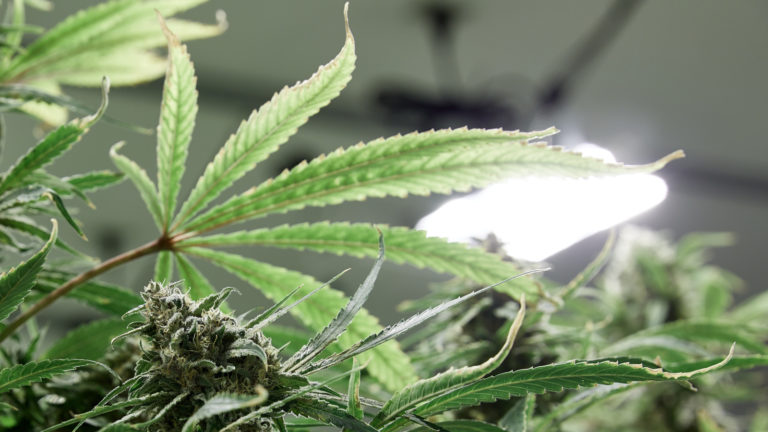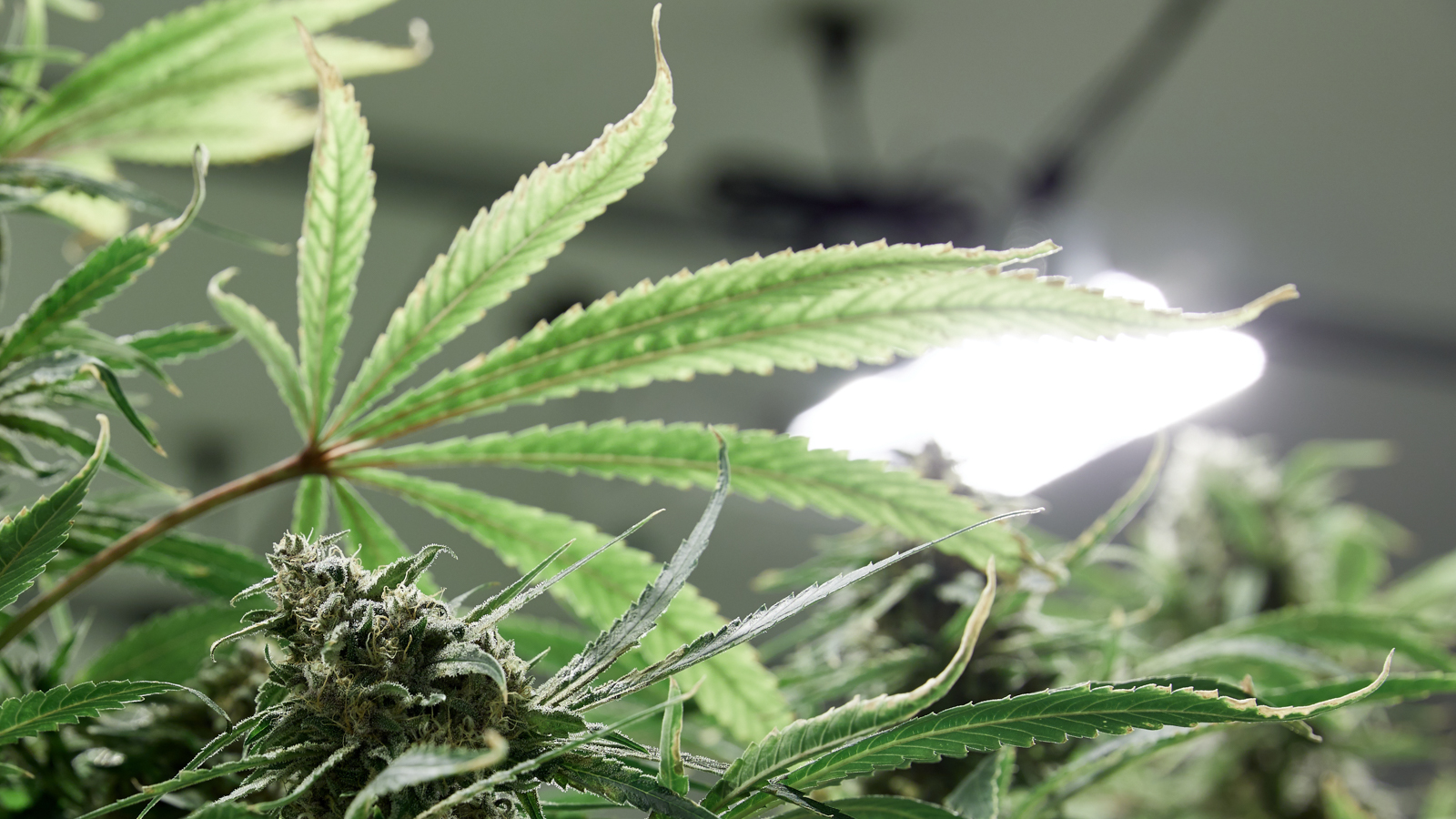Are you thinking about growing cannabis at home? Nurturing your own plant throughout its life cycle from a baby to a fully developed and flowering lady can be an extremely rewarding process.
And while you can build an elaborate cultivation system that will push plants to the epitome of productivity, there is something to be said for starting out simple and customizing your approach as you learn.
This intermediate guide will cover the foundations of growing cannabis indoors and include some helpful tips and tricks for making your indoor grow fun and educational.
Seed or clone?
There's a lot to think about when choosing a plant. Your mind might immediately jump to strains you know and love, or wonder which varieties are easiest to grow. But let's start at the beginning with your baby plant. There are two ways of getting your grow started: seed or clone.
 Photo by: Gina Coleman/Weedmaps
Photo by: Gina Coleman/WeedmapsImage lightbox

The easiest option is starting with a clone, a cannabis seedling that has been cut from a more mature female plant. All you'll need to do is purchase one from a dispensary and bring it home. Another advantage is that clones take the guesswork out of sexing, since all clones are cut from female plants.
What about seeds? While they take more time and work than clones, seeds have some great advantages. Chances are you'll have a lot more choice when shopping for seed versus live clones. There are many seed retailers out there, most of which sell online and can ship right to your door. Each of these seed retailers will probably carry a much wider variety of genetics than a dispensary offers.
You'll need to take special care of your germinated seed, since this is a sensitive time in the plant's development when it's particularly vulnerable to pests, infection, and drastic changes to its environment.
 Photo by: Gina Coleman/Weedmaps
Photo by: Gina Coleman/WeedmapsImage lightbox

Last, while you can buy feminized seeds (seeds that should not develop into male plants), there is always a chance that you get a stray male or two in the mix. This means you will have to learn how to identify male and female plants.
Growing medium
Soil or soilless? That is the question. For a completely inexperienced home grower, it can be as easy as sticking a seedling into some potting soil. But many home growers who make soil their medium of choice really get into all the ways to enrich soil and make it the best it can be for cannabis plants like crafting their own super soil or making the perfect compost tea.
 Photo by: Gina Coleman/Weedmaps
Photo by: Gina Coleman/WeedmapsImage lightbox

Soil is the medium that cannabis evolved and thrived in for thousands of years, so why mess with success? “Cleanliness is definitely an issue if you're growing with soil. It's most likely going to attract insects and it just has a tendency to get everywhere in my experience,” shared Jimmy B Harvests, a YouTuber who documents his adventures in growing cannabis and other plants at home.
“This is where hydroponics is a clear favorite in my eyes. You don't need a fancy hydroponic system, you just need a jar for small plants and a bucket for bigger ones. Hydroponics are by far the easiest way to start growing plants, which is very 'set it and forget it'. I find soil to be a bit more intensive to water correctly,” added Jimmy.
Soil and hydroponics are two of several options available when it comes to cultivation mediums, another that's popular with home growers is called coco coir. “It can be very fun to try something new like coco coir. This grow medium gives you more control over nutrients and can significantly improve the yield and quality,” explained Samuel Belanger of GrowBuds.
Nutrients
Like most things cannabis, you can make nutrients as simple or complicated as you like. Cannabis has specific nutrient needs, and these needs will change as it moves from a seedling into the vegetative stage of growth, and finally into the flowering stage.
If you're using a hydroponic growing system, you'll need liquid nutrients and growers often turn to synthetic formulations. Liquid nutrient systems can be fairly simple, with one catch-all formulation for vegetative growth and another for flowering. Or they can be quite complex, breaking down individual components so growers can concoct their own magic potions for specific cannabis strains, environments, and stages of growth. Add synthetic liquid fertilizers and nutrient solutions to water for use on plants growing in soil.
For soil-based plants, there are more natural approaches to fertilization and nutrient delivery, like the aforementioned super soil and compost teas, or by adding worm castings to the soil, for example. Many home growers use items from their own kitchens to supplement nutrients, like banana peels for potassium or eggshells for calcium. But can you just add these items to the pot of soil willy nilly?
“Food items around the house could be composted and mixed into the growing media, but proper composting is critical to get those nutrients bio-available to the plant's roots. People planning to compost or vermicompost should do some research on their setups to maximize the conversion of food waste into usable plant nutrition,” explained Michael Esposito, a scientist and microbiologist at MCR Labs.
Light
Seedlings and maturing plants in the vegetative stage of growth need lots of light. These plants should get at least 12 and ideally 18 hours of direct light per day, which means if you're growing a photoperiod plant and relying on sunshine alone, you need to time the growing cycle to maximize the increasingly long daylight hours of spring and summer.
While it's totally possible to grow a cannabis plant in your living room without supplemental lighting, adding even just one grow light can give you a lot of bang for your buck when it comes to outcome and yield.
 Photo by: Gina Coleman/Weedmaps
Photo by: Gina Coleman/WeedmapsImage lightbox

“As far as any equipment goes to improve growing success, it's definitely going to be grow lights. Everything else is gravy as you look to take it to the next level, but it's definitely not necessary. It wouldn't make any sense to invest in anything other than a light as a first equipment purchase,” advised Jimmy.
If you choose to supplement your grow space with artificial light, how do you choose which grow lights to go with? Today there are lots of options available for hobby growers, like compact fluorescent light (CFL) bulbs or light-emitting diodes (LEDs), among others. Each has its own pros and cons as far as initial investment, useful life, energy efficiency, and ease of use are concerned, so do a little homework to figure out which is the best option for your needs and cultivation space. “A good accessory would be a small timer to plug the light into and turn it off during the night,” added Belanger.
And while light is critically important to the success of your indoor home grow, we'd be remiss if we didn't mention dark, too. Photoperiod cannabis plants need 12 hours of uninterrupted darkness in order to move out of vegetative growth and into the flowering stage, so if you're not able to control overnight light pollution in your grow room, think about an autoflower variety instead.
Water
Watering is something that many new plant parents struggle with. Are you giving too much? Too little? Should it be reverse osmosis or filtered? For new cannabis growers, it's best to start off simple.
For the majority of home growers, using tap water should be just fine. But in order to be sure, it's best to have a detailed picture of what's in your water.
Bryan Mitchel of cannabis cultivation equipment company Plan C Design recommends picking up a water analysis kit at your local hardware store. “Be sure to look at the chloramine and chlorine section. Chloramine is harmful to a plant's roots and needs to be filtered out of the water before use with a KDF (kinetic discharge flux) filter. If your chlorine levels are more than 30 ppm (parts per million), let the water sit overnight with an airstone in it,” he explained.
You might also need to adjust the pH since this is vitally important to your plant's overall health. Cannabis plants like a pH of 5.8 to 6.2, so investing in an inexpensive pH solution and a testing kit is important for keeping your plants happy.
What about frequency? If you're growing in soil, stick your finger in to about your first knuckle. If it feels moist, you don't need to water yet. Wait until it's dry to the touch. Other grow mediums like coco coir are a little trickier as far as frequency and effort. Coco requires what is called “fertigation,” which is fertilizing plus irrigation. Since coco doesn't hold on to nutrients the way soil or hydroponic solution does, you need to feed your plant every time you water. You will be watering frequently with coco, even when it's still wet.
Hydroponic plants have a water supply they use at will, but take a peek every now and again to check for mold or a greying root structure, which could signal that it's time to dump your reservoir, clean your pot, and give a fresh supply of water and nutrients.
Temperature and humidity
Just like you, plants like to be comfortable. What does comfortable mean for a cannabis plant? Generally speaking, the environment inside your house will be comfortable enough, though there are a few things to keep in mind.
Cannabis plants can tolerate a temperature range of about 70 to 85 degrees Fahrenheit (21 to 29 Celsius) during the day and 55 to 75 Fahrenheit (13 to 24 Celsius) at night. Like most aspects of your grow space, though, ideal temperature needs will vary by strain and genetics.
Remember, too, that supplemental grow lights can increase the ambient temperature around your plants. This is especially important in an enclosed space like a grow tent that doesn't get much airflow. In these cases, you might need an exhaust fan.
Humidity needs vary throughout the plant's life. Seedlings and baby plants tend to need humidity levels of about 70%. Plants in the vegetative state can tolerate humidity in the 40% to 70% range, though experts agree that around 55% is a good happy medium. During the flowering stage, it's important to have a lower humidity of about 40%.
Remember, when you're directly changing humidity by adding a humidifier, dehumidifier, AC, or heater, do it gradually. “We need to have consistent temperature and humidity so the environment is stable for the plant. Sudden dips or spikes will affect the plant and can lead to stress,” added John Hunt from cultivation tech firm Purpl Scientific.
Another way to make things more comfortable for your plants is with good air circulation.
“Airflow is also a key element of raising healthy, strong cannabis plants, as it mimics the natural environment and keeps indoor plants resilient, as well as helps deter mold,” explained Bill Campbell, director of cultivation for cannabis grower CAMP.
The bottom line
If you're new to growing weed indoors, it need not be overwhelming or intimidating. While you can create an elaborate indoor system that will maximize yields and push quality ever higher, you can also start simple and lean into the learning curve. With a little bit of effort and a lot of love, your skills and results will improve with every plant you raise.

